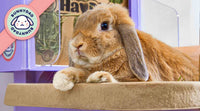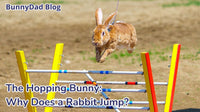Hey there, BunnyBunch!
Today we’ll be discussing Bumblefoot in Rabbits, including addressing some common causes, recognizable symptoms, and effective treatments.
Bumblefoot, also known as pododermatitis, is a painful and potentially serious condition that can affect rabbits. While it is more commonly associated with rodents and birds, rabbits can also develop this ailment.
Bumblefoot is an inflammatory condition that affects a rabbit's feet, primarily the soles, and can lead to severe discomfort and mobility issues if left untreated. In this article, we will explore the causes, symptoms, and treatment options for bumblefoot in rabbits.

Causes of Bumblefoot in Rabbits
Bumblefoot in rabbits is primarily caused by the same factors that lead to pressure sores and ulcers in other animals. The main causes include:
Obesity: One of the leading risk factors for bumblefoot is obesity. When a rabbit is overweight, there is increased pressure on its feet, leading to an elevated risk of developing this condition.
Poor Living Conditions: Housing rabbits in unsanitary or overcrowded conditions can predispose them to bumblefoot. Soiled bedding and wet, dirty cages can provide a breeding ground for the bacteria that can cause the infection.
Inadequate Flooring: Rabbits that are kept on hard, rough, or wire flooring without proper bedding or cushioning are at a higher risk of developing bumblefoot. These surfaces can cause abrasions and trauma to the feet.
Lack of Exercise: Inactive rabbits that don't have enough space to move around and exercise may develop bumblefoot due to prolonged pressure on their feet. 
Symptoms of Bumblefoot in Rabbits
Recognizing the symptoms of bumblefoot is crucial for early intervention. Common signs of bumblefoot in rabbits include:
Lameness: A rabbit with bumblefoot will often show signs of lameness, limping, or reluctance to put weight on the affected foot.
Swelling: The affected foot may appear swollen and warmer to the touch due to inflammation.
Redness or Discoloration: The skin on the sole of the foot can become red or discolored, indicating an inflammatory response.
Pain and Sensitivity: Bumblefoot is a painful condition, and affected rabbits may exhibit signs of discomfort when their feet are touched or manipulated.
Ulcers or Lesions: In advanced cases, open sores or ulcers can develop on the feet. These are susceptible to infection and require immediate attention.

Treatment of Bumblefoot in Rabbits
Treating bumblefoot in rabbits involves a combination of medical and environmental management. Here are the steps for treating this condition:
Consult a Veterinarian: If you suspect your rabbit has bumblefoot, consult a veterinarian with experience in treating small animals. They will conduct a physical examination and may recommend X-rays to assess the extent of the damage.
Antibiotics: If an infection is present, antibiotics will be prescribed to treat the underlying bacterial infection.
Wound Care: Open sores or ulcers should be cleaned and dressed regularly to prevent further infection. Your veterinarian will guide you on the appropriate wound care routine.
Pain Management: Pain relief medications may be prescribed to alleviate the discomfort experienced by the rabbit.
Environmental Changes: Address the root causes of bumblefoot by improving your rabbit's living conditions. This may include providing clean and soft bedding, adequate space for exercise, and suitable flooring to reduce pressure on the feet.
Weight Management: If obesity is a contributing factor, your veterinarian will recommend a weight management plan to help your rabbit shed excess pounds.
Bumblefoot is a painful condition that can severely impact a rabbit's quality of life. By understanding the causes, recognizing the symptoms, and seeking prompt veterinary care, you can help your rabbit recover from bumblefoot and reduce the risk of recurrence.
Additionally, maintaining a clean and comfortable living environment and managing your rabbit's weight are crucial steps in preventing bumblefoot in the first place. Your rabbit's health and well-being should always be a top priority.

We hope this helps in arming yourself with the tools you need to keep your rabbit safe.
See you next time, BunnyBunch!
~BunnyDad








